|
Saturday, July 3rd
I am
leaving Aarhus by train at 8.30 am. Then I’m at Kastrup Airport at noon.
As usual – I am way ahead of the time of my flight. The flight for Tokyo
is at 3.45 pm.
But
finally – at 4 pm – its take-off with SAS to Tokyo, and 11 hours of
flight is ahead.
Sunday, July 4th
I
try to sleep a little, watch some of the movies, read a little – but
with no success. Nevertheless I arrive at the airport of Narita outside
Tokyo at 9.25 am local time – just as scheduled. |
|
Then there’s the usual formality when arriving in
another country. All the people you meet during the formalities are very
polite. When this is done I head for the railway-office to get hold on
my Japan Rail Pass. I also fix a number of reservations for the whole
trip. Then I head for the Narita Express that will take me to Tokyo
Station. From here I take the local Yamanote-Line to Hamamatsucho. Then
there’s a short walk to Sheba Park otel. It’s hot – and with high
humidity – so I do tend to sweat a lot. But then it’s nice to arrive to
the hotel, where they hand me a freezing cold cloth, to help me out.
I
check-in to room 1925 – a shower, some clean clothes and a 2 hour nap –
and I’m on again. I take a short walk through the local neighbourhood. I
visit the temple of Zojoji, and climb the Tokyo Tower with great views
across Tokyo. On the way back to the hotel it starts to rain, and for
the second time I arrive at Sheba Park soaking wet.
Video - rhythms of Zojoji |
 |
Monday,
July 5th
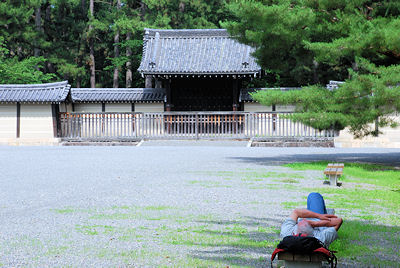 |
Tokyo is a “one-night-stand” right now. I needed the break after the
long flight – and it was cheaper to take the first night in Tokyo, than
just buying the plane ticket.
Therefore I check out from Sheba Park, and head to the local train to
Tokyo Station. From there I take the Shinkansen train to Kyoto. That is
fast – it takes 2½ hour to take me there.
Kyoto is the cultural capital of Japan. There are more than 1.600
temples and 2.400 shrines. It used to the capital of Japan. That was
from 794 to 1868, where Edo – now known as Tokyo – took over.
|
|
So
after a check-in at Toyoko Inn Gojo-Karasuma, the emperor is a good way
to start. The old palace Kyoto Gosho is located in a huge park. You can
get inside, but it’s complicated, so I just take a look from the outside
and take a stroll around the park, with trees, lawns and Japanese people
taking a nap in the afternoon heat. From there I take the Metro back to
my hotel.
It’s
time for a shower and a little nap before my evening walk. That takes me
to narrow streets in my local neighbourhood to Downtown Kyoto. This is
Shopping-Kyoto. But there is also the old street of Pontocho, full of
old wooden-houses. Lanterns and blinds made by rice paper are in front
of the old houses, which now mainly are used for restaurants.
Finally I head for the shopping-streets back to my hotel. |
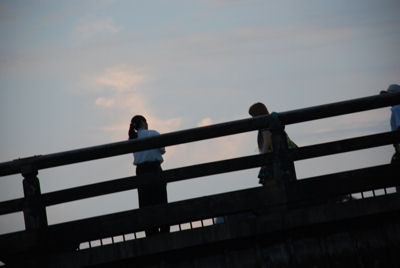 |
Tuesday,
July 6th
|
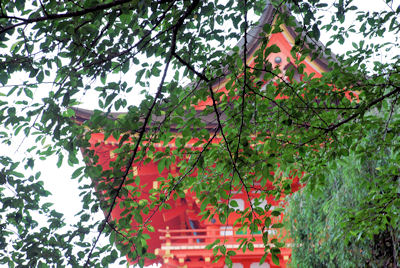 |
I
won’t be able to cover all 1.600 temples, but a sample will be ok. Tour
no. 1 of the day is taken from my Lonely Planet guide. It takes me to
the southern park of Kyoto, known as Higashiyama. I start by walking the
steep hills to the huge Kiyomizudera temple. It’s one of the highlights
in Kyoto, and there are lots of tourists. Originally it was from 798,
but the version standing today was built in 1633. As most temples around
here it is placed in beautiful surroundings.
Then
I head down Chawanzaka – full of souvenir-shops and tourist. I get away
from the hassle and follow some nice streets to the temples of Kodaiji
and Shorenin. I also pass the park of Maryamakoen, before I reach the
Higashiyama station, where I can take the Metro back to the hotel. |
|
The
Late Walk is for the shopping street of Sanjodori. There I visit a local
Pachinko place. It’s a gambling hall – something between a
pinball-machine and a slot-machine. It’s very noisy within, and in
minutes I loose 3.000 Yen. I can’t afford to stay here much longer, so
I’m off again.
From
here I walk to the old neighbourhood of Gion. More old Kyoto-houses made
of wood and with rice paper-blinds – most of them are restaurants here
as well.
I
head back to the hotel via dark streets. There’s nothing to worry about
when walking these streets in Japan. They are perfectly safe.
|
 |
Wednesday, July 7th
|
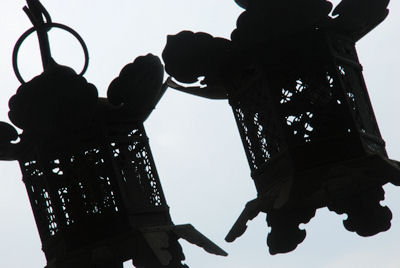 |
I
have slept badly this night. First off all Japanese mattresses are like
rock – secondly I had to wake up in the middle of the night to watch the
World Cup football.
So
I’m pretty tired as I head for this days tour. It’s by train to Nara,
which was the first capitol of Japan. In the outskirts of Nara there’s a
forest, with old temples. The first one – and the most famous – is
called Todaiji. It houses some giant Buddha-Statues and plenty of
tourists. There are fewer tourists at the other temples. Maybe it’s
because they are harder to reach on the tour-bus. But the temples are
just as nice. Nigatsudo and Shangatsudo are almost build together.
Further inside the forest you will find Kasuga Taisha. It’s
orange-coloured and monks are hanging out. While I visit this one the
weather gets bad and it starts to rain. There is thunder and lightning.
But you can stay inside, as long as you remember to leave your shoes at
the doorstep. |
|
When
the rain stops I leave the forest of Narakoen. The forest is also full
of totally tame reindeers, begging for foods from the tourists. They
also go shopping on their own.
The
train to Kyoto is cancelled due to an accident, so the trip back is a
little adventurous. 1 bus and 3 different local trains are involved.
The
evening is quiet. Dinner is at a local Tenkadori. They serve chicken.
They are very understanding and you can get a fork instead of the
chopsticks. And they are so polite. 2 chefs and one waitress is bowing
me all the way out of the restaurant, having spent as much as 10 $ for
my dinner at the place.
Video - Rain over Kasuga
Taisha |
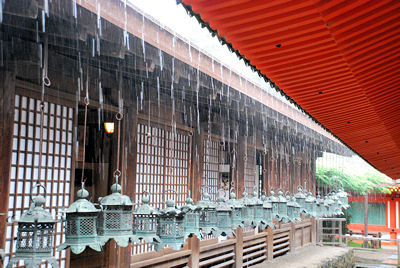 |
Thursday,
July 8th
|
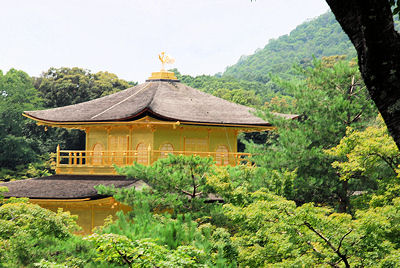 |
It’s
temple-hopping today. It’s all done by local busses, since the Metro is
not to well developed here. The first one is a no. 12 to Kinkakuji –
also knows at “The Golden Temple”. Originally it was build in 1398, but
back in 1950 a monk set fire to the thing. The temple you see now is
therefore a full reconstruction.
At
the exit a group of kids have gathered, interviewing some of the tourist
in English. You have to answer 3 different questions. This reminds me of
a Monty Python movie. Luckily the questions are easy. Where do you come
from? What is your favourite food? and What do you like best about
Japan?. I pass the test – and as a reward gets some homemade thing, that
is meant to be used for lying my nonexistent chopsticks at. |
|
From
there I take a no 12 to the temple of Nijojo. It was built in 1603 for
the first Tokugawa Shogun. You can walk around inside the big temple –
remember – no shoes. The floor cracks as you do so – it’s called a
nightingale-floor. In this way Ninja’s would not be able to sneak
around. Behind the temple there’s a nice park.
Next
no is 204 for Ginkakuji. This one was built by Shogun Ashikaga Yoshimasa
in 1482. This is another fine temple with another fine park surrounding
it.
I’ve
had enough of temples for today. I head back to the hotel on a no. 5.
My
evening stroll is in my local neighbourhood. I take a cheap dinner in
one of the numerous good and cheap restaurants, coffee at Starbucks and
a trip to the Pachinko-hall before my final cup of tea at the hotel. |
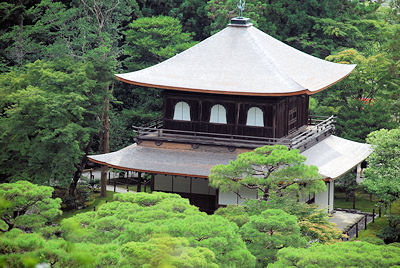 |
Friday,
July 9th
|
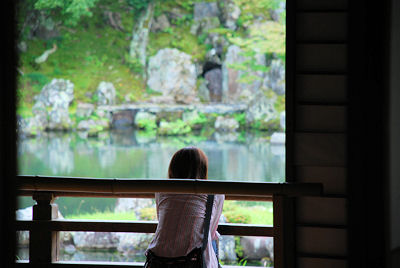 |
I
start the day with a walk to Nishika Market. That’s a food-market. Some
of the stuff looks weird. Japanese food contains ingredients that are
very unusual for someone like me.
From
there I take a no. 11 to Arishiyama in the western outskirts of Kyoto.
Here is another fine temple called Tenryuji. It’s dated back to 1339.
The building that is here now was built in around 1900, but the fine
Japanese garden is back from the 14th Century.
Outside there is a nice bamboo-forest. The trees raise high into the
air, and the almost close at the top, so it’s kind of walking in a cave.
The area around Arashiyama is very nice. There are good possibilities
for a nice walk, so you can skip to tourist-things at the main street.
The main street is full of souvenir-shops, as it tends to be around all
sights in this country. |
|
I
head back to Kyoto by tram. That’s way faster than the bus. It has
started to rain, so this will be my final temple in Kyoto. I head home
for the hotel instead.
The
evening walk is around the Kyoto Station. First I take the elevator to
the top op Kyoto Tower. There’s a nice view around sunset. Kyoto Station
is also impressive. I take the escalators to the 11th floor,
where there’s a skywalk with a view of the whole thing. Accidently the
trip down takes me through a huge shopping-centre. At the exit there are
4 shopping-assistants bowing respectfully to me. They should have known
– I didn’t buy a thing – I just got lost. |
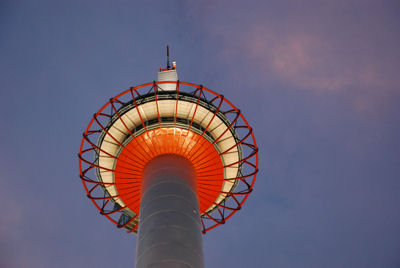 |
To Hiroshima |